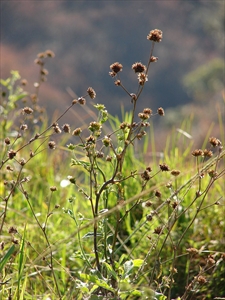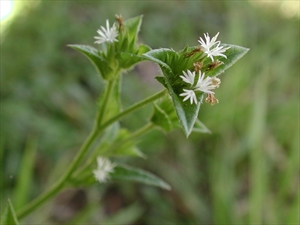- Widespread. Asia, Africa, North, South and Central America, Caribbean, Oceania. In many Pacific islands.
- Aggressive perennial weed of plantations, forming dense stands in sunny, dry, disturbed places, in pastures, where rainfall moderate to high, and threat to native species. Seeds prolifically and leaves of young plants produce thick ground cover smothering competitive species. Cattle do not eat it.
- Fast-growing, up to 1.5 m tall. Forms rosette of leaves, each up to 30 cm long, underside sticky and covered with hairs. One or more branched, flowering stems with smaller, alternate leaves, toothed margins, and winged leaf stalks. Flowerheads white flowerheads up to 2 cm wide, in clusters. Seeds black with bristles.
- Spread: seeds, by fur of animals, clothing, wind; contaminant of pasture seeds; perhaps for medicine and as ornamental.
- Biosecurity: Among 10 most important weeds of Vanuatu. On Global Invasive Species Database of alien invasive species (IUCN, 2020). Noxious weed in Fiji.
- Biocontrol: Fly, Tetreuaresta obscuriventris, introduced to Fiji and Hawaii. Little impact.
- Cultural control: Hoeing; mowing (plus herbicide); plough, disc and harrow; vehicle hygiene.
- Chemical control: in Australia: fluroxypy; glyphosate; triclopyr + picloram; metsulfuron-methy; picloram. Elsewhere, glyphosate or MCPA (Fiji); 2,4-D.
Pacific Pests, Pathogens and Weeds - Online edition
Pacific Pests, Pathogens, Weeds & Pesticides
Elephant's foot (459)
Elephant's foot; it is also known as tobacco weed.
Elephantopus mollis. Some authorities consider it synonymous with Elephantopus scaber, but others keep them separate, although they are closely related. It is a member of the Asteraceae.
AUTHORS Grahame Jackson & Aradhana Deesh
Adapted from Elephant's foot (Elephantopus mollis) (2018) Weeds of SE Qld and Northern NSW. Lucidcentral. (https://www.lucidcentral.org/editors-pick-animal-and-plant-identification-keys/key-to-weeds-of-se-qld-and-northern-nsw); and additional information from CABI (2019) Elephantopus mollis (elephant's foot). Invasive Species Compendium. (https://www.cabi.org/isc/datasheet/41496#tosummaryOfInvasiveness); and Waterhouse DF, Norris KR (1987) Elephantopus scaber Linnaeus. Biological Control Pacific Prospects. Inkata Press, Melbourne. and from CHAH (2020) Elephantopus mollis Kunth Elephant's foot. Department of Sustainability, Environment, Water, Population and Communities. (https://profiles.ala.org.au/opus/weeds-australia/profile/Elephantopus%20mollis). Photo 1 Forest & Kim Starr. Starr Environmental, bugwood.org. Photo 2 Vinayaraj Elephantopus_scaber. Photo 3 Gerald McCormack, Cook Islands Biodiversity & Natural Heritage. (http://cookislands.bishopmuseum.org/). Photo 4 OM Montiel Close-up of the flowerhead.
Produced with support from the Australian Centre for International Agricultural Research under project HORT/2016/185: Responding to emerging pest and disease threats to horticulture in the Pacific islands, implemented by the University of Queensland, in association with the Pacific Community and Koronivia Research Station, Ministry of Agriculture, Fiji.







